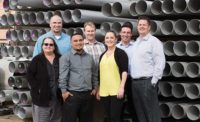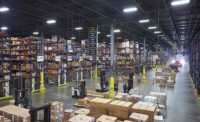Houston, Texas-based industrial PVF manufacturers representative firm Armstrong/Weatherly Associates isn’t afraid to take a risk, express an opinion or try something completely new.
It’s how the firm, skippered by President Harold Armstrong and proudly celebrating its 40th anniversary this year, has become a major success in the topsy-turvy landmine known as in the industrial PVF market.
“We take the business plans of 15 manufacturers and we put them to work,” says Armstrong, during an interview with Supply House Times at the company’s north Houston headquarters earlier this year. “That’s our strength. As market conditions change, you must help the manufacturer adapt or you get outpaced quickly. We excel in how we continually do that. We communicate well with our manufacturers.”
Armstrong, a well-known figure in the industrial PVF industry and a key cog in the tremendous growth and success of the PVF Roundtable networking group based out of Houston, cites a recent conference call with a manufacturer to drive home that point.
“We set up the call at our request,” he explains. “We felt we could change some thought patterns about what was occurring in the marketplace and they were very receptive. We love to communicate. It’s when you don’t communicate where you run into problems. We’ve also worked with some folks who don’t know how to take it. Those are the ones you start watching.”
Constant growth
Armstrong/Weatherly Associates was started in January 1979 as a responsible link between manufacturer and user. Today, the firm has two locations, including its headquarters on Pinemont Drive in Houston that also features a 10,000 square-foot stocking warehouse. AWA also has a new 9600-square-foot south Texas warehouse in Karnes City, plus sales reach in south Texas, west Texas and Louisiana.
AWA has dozens of industry experts on staff with more than 150 years of experience. They specialize in sales and engineering specification influence across Texas, Louisiana and Oklahoma, and provide a responsible channel to complement the buying habits of the PVF industry in their region.
“I love the culture we have here,” Armstrong says. “If I’m going to make a mistake, I want someone in this place to tell me I’m not thinking straight. We have that. I really value our people. It’s easy to make a mistake in business, and reps work on very modest commission structures most of the time, so you don’t have the luxury of a lot of errors. These folks here keep it all together. They are the core of this company and they are so valuable to what we are doing here.”
In addition to being armed with a world-class workforce, AWA also puts to good use the mounds of data it receives from its manufacturers and other industry sources to best steer the companies it represents in the right business direction.
“It’s easy to get outpaced with electronic technology,” Armstrong says. “We utilize a lot of market data. We take much of this information from our principals. I was at a meeting where the president and chairman of this company were concerned about business. I asked them why they were concerned and they said business was falling off. I pulled out a manila folder and showed them they were in a normal business cycle. You have to be the territory expert and we think we are exactly that. We have to be nimble or we won’t survive.
“Competitors are changing. You have to adapt. Your product offering has to change. Look at the valve industry and the number of manufacturers that are no longer around. We wanted to be a responsible link between the manufacturer’s shipping point and the point of installation, and we’ve done that. If we can’t add value, we’re not needed and we will be eliminated.”
Chris Fuller, the firm’s vice president, credits Armstrong with making sure AWA staffers are armed with much more than just manila folders with spreadsheets in them. “Harold is a small-business owner who isn’t afraid to invest in technology,” he says. “Whether it’s iPhones or iPads, he’ll invest and spend the money. When the iPad first came out I had one and was playing around with it, and you could download PDFs from our manufacturers on it. Harold went out and bought iPads for everybody because he immediately saw the value. He’s always out in front of new technology.”
At AWA headquarters in Houston sits a server room that would make companies of much larger scope feel inadequate. The operation is driven by Greenevelyne Hawkins. “She has built something that a lot of big companies don’t have,” Fuller explains. “I could be getting my car’s oil changed and if somebody calls and needs to check inventory, I have it immediately on my phone or laptop. Recently we needed to get a purchase order to a manufacturer late on a Friday. I was at my dining room table for five minutes completing the transaction and we shipped on the following Monday. These aren’t huge expenses, but it’s more the forward-thinking that helps us in the long run.”
AWA also is changing with the social media times. The firm is working with industry public relations/marketing veteran Alicia Branham from Bran Marketing on increasing the company’s social media presence. “We have certain manufacturers that put out content via that route and we need to do that as well,” Fuller says. “How do we cross-promote our lines using those formats? With Alicia’s help, we’ve come up with a strategy for that. There is value there where you might say, ‘Don’t forget about our consigned inventory of these triple offset butterfly valves.’ That might be the trigger that gets someone in.”
Service beyond the sale
Fuller says AWA’s philosophy on cutting-edge technology is similar to its approach with its customers. “Harold has the unique ability to take a deep dive and look at things. Is it going to cost us more now to do it right, or are we going to take a shortcut now and pay for it more in the long run?” he asks.
“We’ve incorporated that mindset into our selling with our customers. We’re selling to some big end users and having great success. We’ve added a service department to help maintain our market share. When we go out and sell, we’re saying this is what it’s going to cost you in the long run to maintain my product. It’s going to cost you X-amount on the front end and then we are going to rehab it. We’re going to come to the field, pick it up, take care of it and put it back in service. Let’s say we do that two more times at half the cost of the new one. My competitor is two-thirds the cost of my product, but when it comes time for refurbishment or to do what we normally do, they don’t offer these services. They are going to have to throw the product out and buy a new one. They might buy three new ones, compared to one of ours. We’ve adapted.”
Nick Papageorge, an AWA sales executive who cover Houston and the surrounding area, says the firm likes to dig deeper into its customer’s product usage in order to maximize value. “Sometimes they will buy the same product, particularly a valve from the same application,” he says. “It’s nice to get repeat orders, but you need to ask questions. Where is this product going and what is it used for? It’s probably maxing out capacity and that’s why it’s failing easily. I’ll tell them I have this other product that will cost a little more, but it’s going to last much longer because it’s designed for that particular service duty. I also like to ask what their down time is costing them. How much money are you losing because you’re not producing the product you make? So even though my product might be 20 or 30% more or even double the price, it could end up costing you nothing in the end.
“When you develop a relationship with a customer you become a value. You’re not just selling products.”
Gene Lake, who covers south Texas for AWA, doesn’t mince words when asked what he feels is the key driver behind AWA’s success. “I’m sucking up, but we have a very good leader,” he says with a laugh. “Nobody works harder than the guy at the top. Harold is thinking all the time. He’s the leader and he’s put in place a lot of very good people from top to bottom. He empowers us to do our jobs and he definitely doesn’t micromanage.”
Fuller adds, “The formula is pretty simple.”
To which Armstrong replies: “It has to be simple or it won’t work. One of the keys is listening to your people. If you don’t listen, you don’t know what is going on.”
Armstrong says AWA won’t be taking its foot off the accelerator anytime soon. “We have some ideas,” he says. “We look for the strengths of each one of our principals and we complement them. The service aspect of our business is growing, and is very important. You have to stick your neck out a little bit and make progress. I’ll measure the risk and we will continue to go forward like we always do. I like continuing to be a responsible link between the manufacturer and the point of installation, but sometimes you have to do something that’s out of the ordinary.”








